A study of a massive star cluster near the Milky Way Galaxy’s center finds that stars are born with no more than 150 times the Sun’s mass.
Donald Figer of the Space Telescope Science Institute used the Hubble Space Telescope to take deep images of the Arches star cluster. When he determined the masses of the cluster’s stars, he found none with more than 150 solar masses.
“This is one of the densest young star clusters in the Milky Way,” notes Figer. He adds that it is about 2 million years old — young enough, that is, not to have already lost its most massive stars through supernova explosions. Containing several thousand stars, the Arches cluster is large enough and close enough for a detailed inventory. “We’re about 90 percent complete in counting all its stars,” he says.
“The Arches cluster could be a unique object,” says Oey. “But our statistical analysis of nine other clusters in the Milky Way and the neighboring Large Magellanic Cloud also demonstrates a lack of extremely massive stars.”
What sets a limit to star masses? Theorists aren’t sure. But Stan Woosley of the University of California, Santa Cruz, explains that as the heftiest stars form, they encounter two effects, either of which could cap their masses. In the first, he says, the growing star reaches a size where its brightness blows away any infalling material.
With the other effect, “which I rather favor,” Woosley points out that the most massive stars (unlike the Sun) are supported by internal radiation. “Above about 100 solar masses,” he says, “the pressure holding up a star comes from light itself. So 150 solar masses might be the last point at which a star is not overwhelmed by its own radiation.”
Extremely hefty stars have been found before. In 1997, Figer and several coworkers reported a star in the Pistol Nebula that weighs 200 solar masses. But, he says, “It’s one of the most difficult stars to model. Our original estimate was 150 to 250 solar masses.”
In addition, he says, work done since that finding was announced shows the cluster containing the Pistol star has an age of 4 million years. This would give the star a significantly older age than the 3-million-year lifetime that the most massive stars can attain. However, he notes, the Pistol star may be a binary pair of stars, each being well under the mass limit.
“Every time we find a star exceeding the limit, it has something funny going on.”











